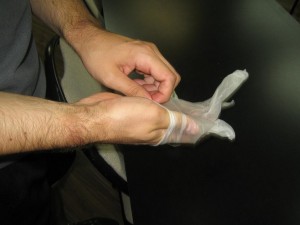Skin Picking Disorder (SPD) is a psychological condition that is characterized by repetitive picking on one’s skin to the point of damage to the skin. Individuals with SPD cyclically pick, scratch, touch, rub or even dig into skin that they perceive to be imperfections or irregularities. These can include acne, moles, freckles, sores, pre-existing scabs or imagined skin defects. A person suffering from Skin Picking Disorder usually uses their fingernails, but may also use their own teeth, tweezers, pins or other tools. This often leads to wounding, bruising, infection and scarring. In severe cases, serious tissue damage and evident deformity are present. The most common area of the body where skin is picked on is the face, although any part of the body may be affected.
Individuals who suffer from Skin Picking Disorder may sometimes present with high tension levels and a strong “urge” or “itch” before skin pricking that is followed by a feeling of pleasure or relief. Most individuals cover their scars, bruises or scabs with make up or clothes that cover the marks. It is most common in teenagers affecting mostly girls.
Skin Picking Disorder is a type of Body-Focused Repetitive Behaviors (BFRBs) wherein the damage often affects one’s appearance or one’s self. Most types of BFRBs happen when one experiences excitement, fear, anxiety or boredom. One can spend hours picking their skin. Often, a person with Skin Picking Disorder also has symptoms for obsessive compulsive disorder (OCD), body dysmorphic disorder (BDD), and Trichotillomania (hair pulling)
Skin Picking Disorder is also called Dermatillomania or Excoriation Disorder.
Causes of Skin Picking Disorder
The causes of Skin Picking Disorder may include but are not limited to:
- Stressful situations
- Trauma
- Obsessive Compulsive Disorder (OCD)
- Depression
- Anxiety
- Fear
- Genetics – individuals who have direct family members with SPD are more likely to develop the same disorder
Signs and Symptoms of Skin Picking Disorder
The following are common signs and symptoms of Skin Picking Disorder in an individual:
- Habitual and repeated picking at the skin to the point that the tissue is damaged
- Significant distress in the individual after picking at the skin
- Excessive concern over appearance
- Issues at school, work, social life or other activities
The OCD Center of Los Angeles offers a questionnaire that can help determine if one is suffering from Skin Picking Disorder found here.
Prevention of Skin Picking Disorder
Professional help is required to treat Skin Picking Disorder. It consists of a combination of different types of Cognitive-Behavioral Therapy, including Habit Reversal Training. There are some ways to prevent Skin Picking Disorder:

- When one feels the urge, keep the hands busy by doing something else. One can apply moisturizer on the face. One can also put on gloves until the urge disappears.
- Keep the skin clean to avoid infection.
- Do away with tweezers, pins or other tools used to pick at the skin.
- Keep busy. Fight off the urge by engaging in other activities.
Understanding Skin Picking Disorder can help when taking first aid courses.
Skin Picking Disorder, also called Dermatillomania, is a psychological condition characterized by repetitive picking on one’s skin to the point of damage.
